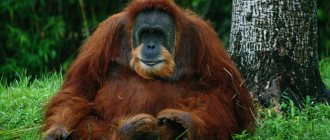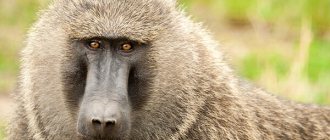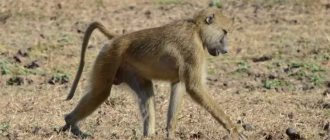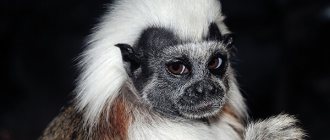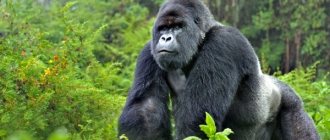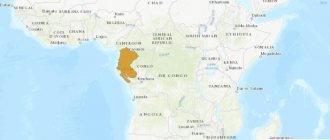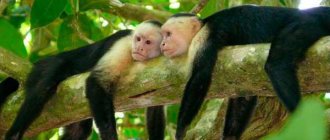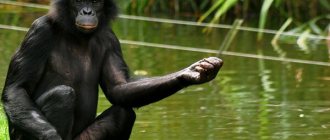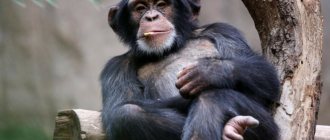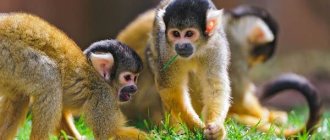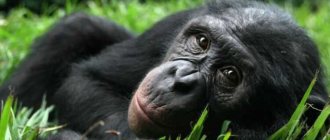Orangutans are apes that belong to the Pongina family of the order of primates. The animal genome is very close to the human genome. Monkeys have a very expressive face, in general they are not hostile and calm, but their habitat today is shrinking due to the influence of human agricultural activities.
This species is the last of its subfamily, but previously it included Sivapithecus and Gigantopithecus. Scientists are still debating the origin of animals. Some believe that they are relatives of Sivapithecus, because the remains of these monkeys, which were found in Hindustan, have similar features to the skeleton of orangutans. Other experts are convinced that this species descended from corapithecus, which previously lived in Indochina.
Carl Linnaeus, a famous biologist, wrote the work "On the Origin of Species" in the 18th century, where Kalimantan orangutans were described in detail. The Sumatran ones were described by another scientist, Rene Lesson. Interestingly, these animals were previously classified as one species. At the end of the 20th century, a new species was found, which was called the Tapanul orangutan, but it was recognized only in 2022. Individuals live on the island of Sumatra.
Appearance and subspecies
The Kalimantan orangutan is quite tall when it stands on its hind legs. So, the height of males is about one and a half meters, and females are a little more than 100 centimeters. Males are larger in every way: they weigh about 80 kg, in contrast to small females, whose weight is about 40 kg. But besides this, males have huge fangs and growths on their faces. There is no hair on the animal's face; the skin in this area is dark in color. The orangutan has a wide forehead and a large jaw. Monkeys' teeth are also powerful, because they use them to crack nuts. The eyes are located at a short distance from each other, and the gaze very often seems kind. These animals have nails that are similar to humans.
The orangutan's hair is red in color with a brownish tint. The wool itself is tough. The cover located on the head and shoulder area grows upward, and in other places - downward. The vast majority of the cover is located on the sides of the body.
The animal's brain is small - only 500 cubic meters. cm, compared to other species of monkeys, this organ in orangutans is quite large and developed. Because of this, many scientists claim that orangutans are the smartest of their kind.
Individuals of the Sumartan subspecies are practically no different from their relatives, only in their small size. Tapanul orangutans have small heads and their fur is more prone to curling. A special feature of the Kalimantan fish is that special growths located on the cheeks allow them to have contact with females. In turn, the Sumartan subspecies has such growths only in dominant male individuals.
Sumatran orangutan
Life cycle
In nature, the lifespan of an orangutan is approximately 30-40 years. Females reach sexual maturity at 8-12 years, males at 14-15 years. The female gives birth once every 3-4 years.
Where does it live?
Typically these animals live in wetlands in the tropics. There is always a dense forest there, which is important, because orangutans are in the trees almost constantly. In the past, these monkeys could be found in southeast Asia, but now they live only in Sumatra and Kalimantan.
The Kalimantan subspecies is much more common than others; they can be seen in the north of the island. The Sumartan also occupy this territory, and the Tapanul prefer to be isolated from other subspecies in Batang Toru. Their habitat is very small - less than a thousand kilometers square.
Animals never like to come down from trees, so they often use vines to move around in the trees. Orangutans also do not like water and do not visit watering holes, because they get everything they need from food and drink moisture from hollows.
Orangutan on a tree
Find 28 matches
In order to clearly demonstrate to their anthropological colleagues the solidity of the hypothesis they defended, Schwartz and Grehan made a detailed revision of various anatomical (as well as a number of physiological) features of both extant species of great apes and long-extinct species. Hundreds of physical characteristics were subjected to comparative analysis, which in modern science are considered as the most significant evidence of the evolutionary kinship of humans and apes (among the latter, the “big three” were primarily studied - chimpanzees, gorillas and orangutans).
First, by selecting from this large set the 63 most important characters, that is, only those that, according to Schwartz and Grehan, are unique to all living members of the family Hominidae - humans, chimpanzees, gorillas and orangutans - and not found in other primates, American scientists have found that humans and orangutans practically have 28 of them in common, while we have only seven in common with gorillas, and only two with chimpanzees (another seven traits were common to all four species studied, and in 11 traits there was significant similarity between gorillas and chimpanzees).
Next, for morphological analysis, Schwartz and Grehan selected 56 specific characteristics that unite modern humans, fossil hominids and extinct apes. This time, anthropologists came to the conclusion that eight of them are common to orangutans, early Homo and australopithecines (the putative ancestors of humans or, more broadly, the large family Hominidae) and for another seven there is significant similarity only in orangutans and australopithecines. At the same time, chimpanzees and gorillas had no such common characteristics with early Homo and australopithecines. Thus, Schwartz and Grehan note in their article, the mainstream hypothesis, which is based on DNA analysis data and according to which the most ancient ancestors of humans should have primarily revealed common features with chimpanzees and, to a much lesser extent, with orangutans, has been greatly questioned.
Having compared the results of these two comparative studies, American experts are pleased to have brought modern humans, their extinct ancestors and orangutans into a new separate group of “dental hominoids”, so named due to the presence of thick tooth enamel in all its representatives. He, in turn, assigned the “disgraced” chimpanzees and gorillas to another group, which, without further ado, was simply called African apes. Arguing for this alternative classification, the authors of an article in the Journal of Biogeography explained that "although African apes can be considered a closely related group of dental apes, they are significantly further removed from humans than orangutans."
What do they eat
In general, monkeys prefer food of plant origin. So, they eat leaves with shoots, like to eat buds and bark. They do not ignore fruits such as mango and banana, and durian can also be eaten.
One of the most favorite delicacies is honey. They are constantly looking for hives, although they know that it is dangerous. Eating also takes place in the trees, and animals can only descend if their eyes fall on something tasty from below.
Orangutans also eat insects with larvae, and can eat the eggs of birds and their young. If there is practically no food, then individuals from the Sumatran subspecies eat small loris primates. Tapanul orangutans often eat caterpillars.
Because their diet is quite low in minerals, animals are forced to eat soil. Animals have a slow metabolism, which is why they are weak, although they do not eat much. They are capable of not eating for several days and this will not affect the body.
Behavior
These are peaceful representatives of primates. They are loners and practically do not live in groups. Sometimes the male maintains a "harem". The habitat is divided between individuals. There are almost never wars between them and very rarely fights.
If a stranger wanders into the male’s territory, then, as a rule, it does not lead to war. Males use a “psychic attack” - they create a lot of noise and screaming.
At the same time, they not only make various sounds and yell, but also break branches and shake trees until someone gives up first and leaves.
Lifestyle
Orangutans prefer privacy, they are quite developed, as they can use tools for hunting and obtaining food. In captivity, animals can adopt some human habits that they consider useful. The means of communication are sounds with which they express anger, joy, and warning of approaching danger.
Animals' body structure helps them in everyday life. They cling perfectly to branches with all their limbs and can travel long distances, moving from tree to tree. They also sleep at altitude, which is why they create nests. To learn how to do this, they begin to practice almost from birth. Orangutans take a couple of years to train.
In the process, they sleep next to their mother, because otherwise they can crash in an unreliable nest. However, then the females do not allow them to come to them, and the cubs build their own home. Their “home” is not devoid of comfort, because orangutans put leaves there and look for soft branches with which they can cover themselves like a blanket. In captivity they learn to use it too.
Natural enemies
Orangutans are a rather difficult type of prey for many predators, since they live in the crowns of trees and rarely appear on the ground. In Kalimantan there are practically no predators that could hunt adult orangutans. In addition, orangutans are not weak or small. As for young individuals or cubs, they can be attacked by crocodiles, pythons and other predators. Sumatra is home to tigers, which pose a serious threat to adult orangutans. Despite this fact, the main threat is not predators, but human activity.
The influence of human activity is felt, despite the fact that these animals live far from civilization in the dense forests of the tropics.
Humans are cutting down forests, reducing natural habitats. Many animals die from poachers, and some of them end up on the black market, since orangutans are highly valued. Interesting moment!
As a result of observations, experts have established that orangutans also communicate with each other using gestures. They counted about 6 dozen of them. They use gestures to draw their attention to some event. With the help of gestures, they invite their relatives to mutually examine their fur. Gestures are also used if it is necessary to share food or ask the intruder to leave the territory. With the help of gestures, orangutans warn their relatives of approaching danger. The advantage of gestures is that the warning is carried out unnoticed by natural enemies.
Society structure and reproduction
Males usually mark their territory, dividing it among themselves, and are never in someone else’s territory. However, if this happens, they begin to show their fangs and scare each other in every possible way. After this, the weak male leaves the foreign territory, but sometimes it ends in a fight.
Thus, the social structure of these monkeys is radically different from that of gorillas. Animals never create groups; the male never lives with the female and offspring. Interestingly, for every one male there are a dozen females.
Orangutan with baby
Sometimes animals do gather, but this happens near attractive trees with juicy fruits. There they actively communicate with sounds and gestures. Scientists have discovered that they use several dozen gestures to invite someone to play or show something interesting. They also often communicate to clean the other individual's fur of insects and dirt. Equally important is the request to leave your territory or share food. Sumartan orangutans are the best at interacting with others, since there are a lot of predators in their habitats and it is beneficial to stay together.
Females become sexually mature at about 8-10 years, and males at about 13-15. Usually only one baby is born, less often twins are born. The weight of the newborn is 2 kg. The female can give birth to another only after 7-9 years. This is due to the fact that adaptation to very productive periods when the birth of a baby is possible. It is also important that the mother raises her child for about 8 years, 3 of which he feeds on her milk.
Mothering
The cub learns from other anthropoids by looking at all members of the group. Fathers, mothers, grandmothers, aunts, uncles, older brothers - the world is gradually gaining adult life skills. And only the mother teaches the baby orangutan. Therefore, orangutans have a long childhood, they are fed milk until they are four years old, and then live with their mother for another couple of years. Every good orangutan mother should teach her child many things, such as:
Build a nest: orangutans spend the night in nests made of leaves, and in the rain they also attach a kind of umbrella on top. And to prevent parasites from appearing in the nest, a new one is built every evening.
Distinguish between edible and inedible: the teaching technique is as follows: the cub tries to eat something inedible, the mother lightly spanks it, sniffs the inedible object and lets it smell it. The cub remembers what smell he received the slap for, and henceforth tries to avoid it.
Catching termites: We saw a five-year-old “guy” sitting in a tree with a rotten log full of termites and fishing them out with his fingers. And some advanced mothers teach their children to get termites with twigs.
The cub hangs for 8–9 months, clinging to the mother’s fur.
Orangutans are very responsible mothers, and until they teach the baby all the vital wisdom, they will not have another. As a result, orangutans rarely reproduce in nature. Males, of course, would be happy to spread their genes more often, but they do not have such an opportunity. If you come to a female without an invitation, she will simply climb higher and blow kisses from there to mean “go away.” And the male leaves. What can he do? He weighs about a hundredweight, she is half as much, and all attempts to catch up with the female will end with him falling and breaking something.
It's better to wait for an invitation.
In captivity, relationships between orangutans are different, and females have to get used to the constant company of a male again. But cubs are born in nurseries more often on average, once every four years.
In general, wild orangutans are afraid of people and avoid them. And there is a reason for this: people really annoyed them a lot. Due to poaching, and even more due to the clearing of the jungle for oil palm plantations, the number of wild orangutans has decreased to endangered in Kalimantan and critical in Sumatran. In order to somehow improve the situation, Birute Galdikas opened an adaptation nursery for baby orangutans left without a mother at the Liki camp. People literally replaced the primates’ natural mother: they fed, cared for the cubs and taught everything that a self-sufficient orangutan should be able to do. Above the path in the depths of the forest we were met by the daughter of one of those “graduates”. The guide recognized her: “Ursula, Ursula!” Ursula looked at us with curiosity and without fear. She was born and raised in the jungle, but she learned from her mother that people are not dangerous. You can play with them, but if you get tired of them, drive them away with a branch.
Of course, I had to dodge the branch. But in general, it’s great when a representative of the first unafraid generation of wild orangutans drives you away from their territory.
Photo: SPL / Legion-media, NPL / Legion-media (x6), iStock, Alamy / Legion-media
The material was published in the magazine “Around the World” No. 2, February 2016
Orangutan and man
Animals constantly suffer because people simply cut down their habitats; the poor creatures are often hunted by poachers. Orangutans are sometimes brought alive to the black market to be stuffed. Most often, mothers are killed because they do not give their offspring into the hands of poachers. Instead of the usual forests in the habitats of animals, people plant oil palms, which reduces the population. There are also many inbreeding experiments being carried out, which wipe out hundreds if not thousands of individuals every year.
Threat to survival
A pair of orangutans (male and female) in a safari park near the city of Ramat Gan in Israel.
Orangutans are critically endangered in the wild, mainly due to ongoing habitat destruction. Despite the creation of national parks, deforestation continues, now illegally. Another serious threat is the poaching of baby orangutans for the illegal trade. In this case, the mother is usually killed because she will not give up her child.
The status of the Sumatran and Tapanul orangutan is critical
.
The Kalimantan orangutan is in danger
.
Interesting Facts
- Orangutans are active during the daytime. They wake up at dawn and search for food for several hours.
- Animals build nests at a height of 5 to 30 meters.
- The dwarf orangutan is considered a very rare species. Today you can meet these amazing animals on Barneo.
- They use leaves to wipe their faces from fruit juice, and with branches they try to scare away bees while eating honey. Animals also use the leaves to extract prickly fruits. They are also used to create special sponges for drinking water.
- Animals have movable hip and shoulder joints, which is why they can do the splits.
- Animals often find creative solutions to problems. They can build hammocks and create various knots.
- Orangutans are good at scaring away predators by folding their hands into a tube and putting them to their mouths while screaming.
- The animals' arms are very long, their span is about 2 meters. When the individual is in an upright position, the arms can reach the animal's feet. They play the role of support when moving on the ground.
- The thumbs can be opposed to the others and are usually quite curved.
- The female carries the cub for approximately 9 months.
- The animals travel about a kilometer every day.
- Adult males live in an area of 2 to 6 square km.
- Many cubs die from pneumonia or malaria.
- The animals first produced offspring in captivity in 1928, but it was only by the 1970s that they began to do so consistently.
- In zoos, orangutans are fed bread, various types of cereals, nuts and juices. Animals love to drink compote and tea. They are also often given watermelons and melon. They are fed several times a day.
- Previously, animals in enclosures were occupied by special puzzles from which food could be obtained using chopsticks. But when they got tired of it, the orangutans began to climb in there, and later destroy these puzzles.
- In the zoo, animals often scatter food around the enclosure due to boredom. They love to build nests out of straw and climb into cardboard boxes. Orangutans can collect seeds from hay for a long time.
- A male who has reached sexual maturity often emits a loud cry that can be heard several kilometers away. But it does not attract females and does not repel other males.
- Orangutans are very easy to train and are less aggressive than chimpanzees.
- Animals can become addicted to tobacco, as described in Verne's The Mysterious Island.
- With age, monkeys' hair can become browner and grow up to 40 cm in length.
- A pregnant female has privileges: other individuals always allow her to be the first to the feeder.
Orangutan lifestyle
Unlike most primates, which live in families, it is not typical for orangutans to live in a group of their own kind, and they lead a solitary lifestyle. But there are also exceptions to the rules. Thus, during the period of raising cubs, females can form a family for some time, which includes 2-3 long-armed mothers with babies of different ages. Young males also form a sort of bachelor group for a short period of time until each of them acquires their own territory.
Adult males prefer proud loneliness and a serene existence, unencumbered by friendly relations and care for offspring.
Lifestyle of orangutans
Orangutans spend almost their entire lives in trees, where they feed, rest and sleep. If the tree has a lot of ripe fruits and juicy young leaves, the primate can stay on it for several days. As soon as food supplies run out, the animal moves to a new tree crown.
Almost the entire life of an orang tutan is spent in the canopy of trees.
Orangutans have become so adapted to their arboreal life that when changing a dislocation site, they do not even bother going down to the ground, but deftly move between the crowns, clinging to thick branches with their long limbs. If the target is too far away, the monkey uses the vines, skillfully maneuvering on them like a circus acrobat.
Orangutans rarely descend to the ground; this happens if they find something interesting below, for example, a ripe fruit that has fallen from a tree. On the other hand, adult individuals sometimes like to walk through the forest, or sit on a fallen trunk, admiring the evening sunset.
Arboreal primates are diurnal, being most active in the early morning and afternoon. In the morning, the orangutan goes in search of food, then takes a rest, after which it feeds again until the evening. These monkeys always sleep in the crowns of trees, and for night sleep they build themselves a cozy nest, connecting branches and leaves together. What’s amazing is that such primate night dwellings are disposable; the orangutan never sleeps in the same shelter, and builds a new nest for the next rest.
Social and territorial structure
Most orangutans prefer a sedentary life and occupy a certain territory, which they consider their personal domain. The tree plantations of males have an area of 4,000 to 5,000 thousand hectares, while the areas of females are more modest and extend over 70-900 hectares.
Female orangutans decided to relax and gossip a little
Female representatives are very peace-loving and loyal to their fellow tribesmen. Several females calmly coexist in the same territory; when they meet, they disperse peacefully, and can even have a joint meal. But males are not particularly friendly when it comes to protecting their own areas. Only females are allowed to settle on their property, and other males are strictly prohibited from entering.
Usually, orangutans are quite tactful; they do not tend to invade other people's territories. If the red-haired owner notices an uninvited guest on his personal territory, he will try to drive him away, demonstrating his superiority: he growls menacingly, breaks branches and bares his teeth, and this is enough for the stranger to realize his mistake and hasten to retreat. In rare cases, it comes to a real fight, although during the fight the orangutans do not show much cruelty, and after 1-2 rounds one of the opponents admits himself defeated and hides in the thicket of the forest.
Among orangutans there are also male nomads who enjoy a free, adventurous life. From a young age to a very old age, they wander throughout the forest, not staying in one place for long. At the same time, nomads remember places abounding in fruit plantations, and when the harvest ripens, they return there to enjoy plenty of fresh fruits.
Character and habits
Many representatives of the monkey family are famous for their aggressive behavior, they are especially cruel when challenging their leadership or the right to own a female. But orangutans have a completely balanced and peaceful disposition. Yes, conflicts over territory sometimes break out between adult males, but in general, arboreal primates are not characterized by hostility and uncontrollable rage. They never try to harm their fellow tribesmen, and if they meet by chance, they disperse peacefully in different directions.
Young orangutan learns skills from adult primate
Despite the fact that orangutans lead a solitary and not collective life, they often interact with each other, and even form temporary alliances. In most cases, females with cubs are united into a family of several individuals. And such unions are very important for young animals. After all, young orangutans not only get the opportunity to communicate with their peers, but can also observe the actions of adults, learning new skills along the way.
Adult males also sometimes gather in “boys’ clubs” to share news, or simply have lunch in a pleasant group. True, such meetings are typical for Sumatran orangutans, who have to fear huge tigers, and in the company of their own kind they feel safer.
Orangutans are not very talkative animals. Although these primates are capable of making a variety of sounds, ranging from screams and whimpers to menacing roars, they communicate with each other more through movements and waves of their hands. Moreover, tree monkeys have a set of more than 60 gestures in their arsenal. It is through body movements and touches that orangutans express their feelings and emotions. For example, animals have certain gestures that indicate a call to play, a request to share food, or an invitation to go for a walk together.
Orangutans also know how to make primitive household tools. When it rains, they look for wide leaves, covering their heads with them like umbrellas. Primates also use leaves as gloves when they need to pick up prickly fruits. Monkeys use thin pointed sticks to scratch their backs. They string insects onto long branches and extract honey with them, because orangutans know very well not to stick their paw into a hive full of angry bees.
Orangtuans living in parks and reserves often come into contact with people and adopt many of the habits of their two-legged friends. Thus, primates easily learn to open cans of carbonated drinks, adopt the science of weaving hammocks from ropes, and even enjoy smoking a pipe, filling it with tobacco themselves.
Poll: have you ever seen an orangutan in a zoo?
Yes, and I really liked these friendly monkeys.
25%
Yes, even the staff allowed us to treat the orangutan to a banana.
25%
No, but I would like to see them live.
50%
No, it makes me sad and painful to look at animals in captivity.
0%
Voted: 4
Orangutan conservation
Individuals who live in Borneo know firsthand about snake bites. There are more than 150 species of these dangerous animals, some of which can kill monkeys. There is a special fund on the island whose employees help animals by purifying water from snakes. Wounded animals are also cared for there; animals are often shot with metal bullets.
There are rehabilitation centers in Sumatra and Kalimantan. There they raise cubs who have lost their mother, raise them and feed them, and then release them into the wild. They teach kids a lot: finding edible food, protecting themselves from attacks by predators. Since the organization began its work, about 200 individuals have been rehabilitated.
